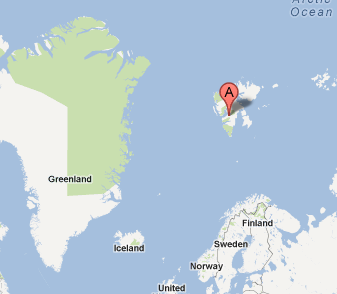Dying at All is Not Allowed

Throughout the ages, governments have banned seemingly everything — other than death and taxes, or so the saying implies. But the administrators of a settlement in Svalbard, Norway, are trying to change that, at least insofar as death is concerned.
The settlement, called Longyearbyen, has a population of roughly 1,500 to 2,000 people. It is one of the northernmost places on Earth with any semblance of permanent residents. Located 78.22 degrees north, it is well within the Arctic Circle, as seen above. There are polar bears everywhere and, as one would guess, the temperatures never reach what most would consider “warm.” It is that latter point that led to the ban on dying.
Before the ban, like anywhere else, people in Longyearbyen buried their dead. That makes sense — over time, the bodies of the deceased will decompose. Ashes to ashes, dust to dust, so to speak. In 1917, the Spanish flu pandemic hit Longyearbyen, leading to the death of a number of residents, and they were buried in the town cemetery. Thirteen years later, someone discovered that Longyearbyen was not like most other places. As the BBC reported, the bodies in the cemetery weren’t decomposing. The cold earth had preserved the corpses and, unfortunately, had also kept the influenza strain alive.
There is no reason to believe that anyone was infected by the resurrected influenza, but regardless, its discovery provided a warning to the town officials. Realizing that Longyearbyen, quite isolated from the rest of the world, had no way of handling its dead — and at risk to the living — its leaders simply declared that dying was not permitted in the town.
Enforcement, of course, cannot be done via punitive action — “don’t die, or else!” is a strange ultimatum, to say the least. Rather, Longyearbyen prevents people from dying in town by a system akin to an administrative hokey-pokey. The cemetery closed in 1930, accepting no future burials. The population is generally kept young; there’s no elder care housing in the area. And if you fall deathly ill? The local authorities will airlift you to the nearest regional hospital, two hours away.
Bonus fact: Longyearbyen is home to both the University Centre in Svalbard (UNIS) and a lot of polar bears as well, as noted above in passing. These beasts are savage and do not take kindly to people. So when a student, faculty member, or staff member enters UNIS, he or she goes right to class — riflery class, that is. Everyone at UNIS is trained on how to use a rifle to defend themselves from the polar bears.
From the Archives: The Boat in the Middle of Nowhere: Another island under Norway’s control that has a unique role in the world. Also, Invisible Polar Bears: How do you count what you can barely see?
Related: A life-sized polar bear. Choose between crouching, standing, or dressed as a Christmas-time butler (!).

Leave a comment